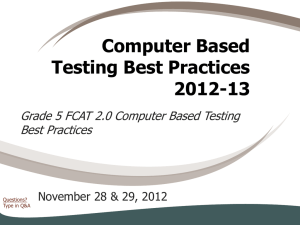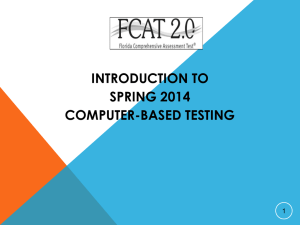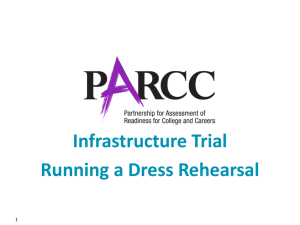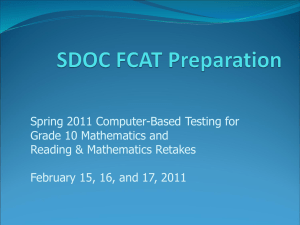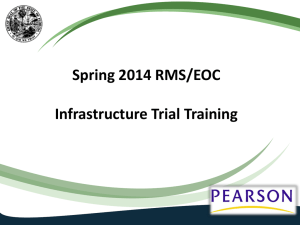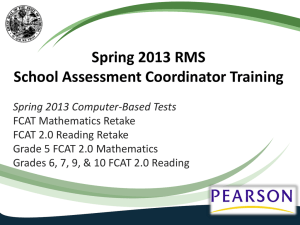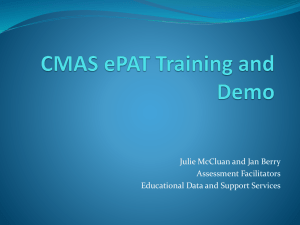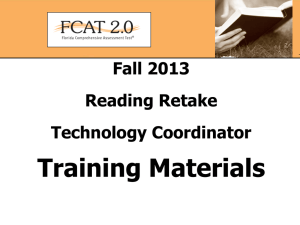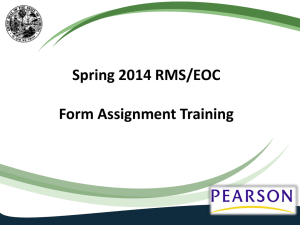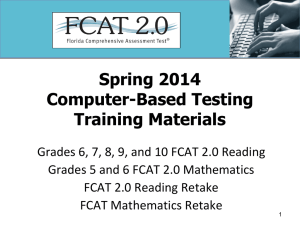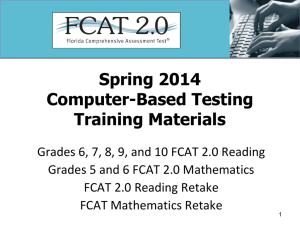Seal Code
advertisement
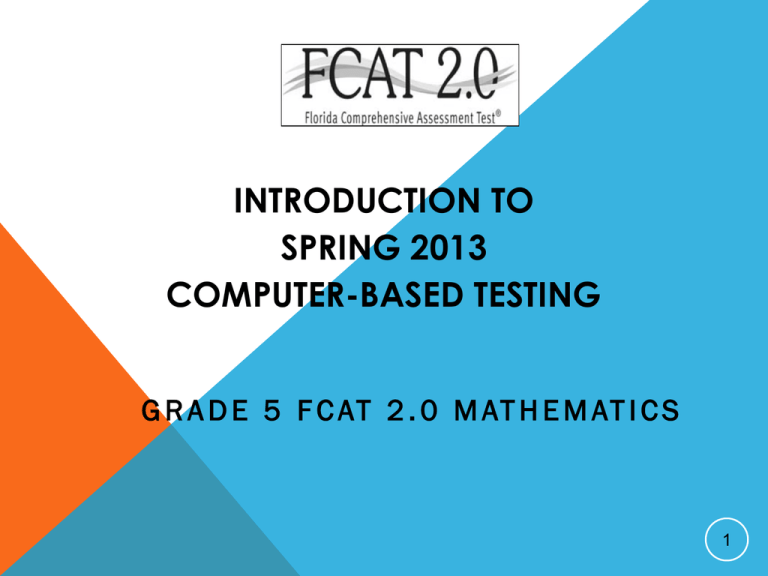
INTRODUCTION TO SPRING 2013 COMPUTER-BASED TESTING G R A D E 5 F C AT 2 . 0 M AT H E M AT I C S 1 COMPONENTS OF COMPUTER-BASED TESTING 1. 2. 3. 4. 5. 6. Participate in District-Wide Infrastructure Trial (brown site) Complete State Certification Process ePAT Students Create Test Sessions in Pearson Access (blue site) Enroll New Students as Necessary Manage Test Sessions Authorization Tickets, Session Rosters, Seal Codes Cache sessions Start sessions Resume students Stop sessions 2 GLOSSARY OF TERMS PearsonAccess – www.pearsonaccess.com/fl (the blue site) • A website used for almost all test preparation (e.g., PreID), setup, administration, and reporting tasks. • Correct test administration must be selected each time you log in. • Requires a username and password. • Links to support materials: www.FLAssessments.com/SpringRMS • PearsonAccess will timeout after 14 minutes of inactivity. TestNav and TestHear do NOT timeout. 3 GLOSSARY OF TERMS PearsonAccess Training Center (the brown site) Accessed from the Training Center tab on PearsonAccess Home page. Provides an opportunity to Practice PearsonAccess tasks Manage the Infrastructure Trial in preparation for testing Requires a username and password. 4 GLOSSARY OF TERMS Proctor Caching • Proctor Caching is a process of loading or “caching” test content locally on a computer at the school level. • Does not require a separate caching server and can run on any workstation on the network that meets minimum requirements. • Proctor Caching software is provided by Pearson. • Reduces test delays due to network congestion. • Provides students with a more seamless testing experience. • Required for all FCAT/FCAT 2.0/EOC computer-based testing in Florida. 5 GLOSSARY OF TERMS TestNav 6.9 (TestNav) • Platform for Florida’s high-stakes computer-based statewide assessments. • Software application installed either on a file server or on each computer that will be used for testing. 6 TestHear GLOSSARY OF TERMS • Platform used to deliver accommodated forms (e.g., large print, zoom, color contrast, screen reader, assistive devices) for Florida’s high-stakes computer-based statewide assessments. • Software application installed on each computer that will be used to test students who require computer-based accommodations. • TestHear will operate on Windows PC workstations and on Macintosh workstations that have Mac OS 10.5 or later installed and are running Windows (e.g., via Boot Camp). • TestHear will not work on Mac OS X 10.4 or on Macs that cannot also run Windows. • It is recommended that TestHear be installed on a hard-wired computer (not on a workstation using wireless Internet connectivity). 7 GLOSSARY OF TERMS ePAT • Electronic Practice Assessment Tool • Students are required to take an ePAT for each computer-based test subject. • A script is used to administer the ePATs. • Students can practice additionally without hearing the script. • Provides students an opportunity to practice using the computerbased platform prior to testing. • Available for download at www.FLAssessments.com/ePATs. • Download ePAT launcher separately from test content. • Accommodated ePATs are also available. Launcher is bundled with the practice test content for accommodated forms. 8 PEARSON SUPPORT Contact Pearson Support • Phone Number: 1-877-847-3043 • E-mail: Florida@support.pearson.com 9 COMPUTER-BASED TEST SCHEDULE April 22-26 (Make-up testing is permitted through April 30) Grade 5 FCAT 2.0 Mathematics Two 70-minute sessions over two days 10 CBT DAILY ADMINISTRATION SCHEDULE Grade 5 FCAT 2.0 Mathematics • Grade 5 FCAT 2.0 Mathematics is a computer-based test and will be administered in two 70-minute sessions over two days. • The computer-based testing window for Grad 5 Math is April 22 – 26. • Make-up testing can occur through April 30. 11 CBT SPRING 2013 SEAL CODES • Students participating in Grade 5 Mathematics using TestNav must enter a seal code to open Session 2 on Day 2 of testing. • Students are not able to return to Session 1 once they have logged in to Session 2. Students will log in using the same Student Authorization Tickets for both test sessions. • TestHear accommodated forms do not require a seal code to begin testing on Day 2. 12 MATERIALS NEEDED FOR TESTING Student Authorization Tickets • For each test session, each student needs a Login ID and a test code (password), which are printed on the Student Authorization Tickets. • Students will need a pen or pencil during testing to sign their tickets. • Students taking the FCAT 2.0 Grade 5 Math test will log in using the same Student Authorization Tickets for both sessions. 13 MATERIALS NEEDED FOR TESTING Student Authorization Tickets (cont.) • Student Authorization Tickets must be handled in a secure manner and returned to the school assessment coordinator immediately after each day of testing is completed. • The test administrator will give each student a ticket only AFTER all students have entered the testing room, as instructed in the script, and all tickets must be collected BEFORE students leave the testing room. 14 MATERIALS NEEDED FOR TESTING Student Authorization Tickets (cont.) 15 Session Roster MATERIALS NEEDED FOR TESTING A Session Roster is a list of all students scheduled in a test session that displays important information including: Test Administration Session Name Test to be Administered Test Code (password) Student Name Student ID Student Date of Birth Class information Login ID Blank space to record attendance information and accommodations used. The Session Roster may be used to record required administration information. 16 MATERIALS NEEDED FOR TESTING Session Roster (cont.) • Session Rosters must be handled in a secure manner and returned to the school assessment coordinator immediately after each test session is completed. 17 MATERIALS NEEDED FOR TESTING Session Roster (cont.) 18 MATERIALS NEEDED FOR TESTING Test Group Code • A test group code is a unique four-digit number used to identify a group of students testing together. • Each group of tested students, initial and make-up, in a testing room should receive a unique test group code. • • • District assessment coordinators will either create and distribute test group codes to all school assessment coordinators or will instruct them to create their own unique four-digit codes. Students will enter the test group code before beginning the test, as indicated in the scripts. 19 TEST CODE & TEST GROUP CODE Test Code Test Group Code A six-digit code created by PearsonAccess and printed on Student Authorization Tickets and Session Rosters. The Login ID and the test code are required to log in to TestNav. A unique four-digit number created by district assessment coordinators or by school assessment coordinators used to identify groups of students tested together. The test group code is entered after the Welcome screen in TestNav and before students see the first question. 20 Seal Code MATERIALS NEEDED FOR TESTING • A seal code is a unique four-digit number used to allow students to access Session 2 of the computer-based FCAT 2.0 Grade 5 Mathematics tests after they have completed Session 1. • Seal codes will be provided in PearsonAccess, and all students in a test session will use the same seal code. • Seal codes should not be given to students until directed to do so on Day 2 when Session 2 is administered. • TestHear accommodated tests do not require a seal code to proceed to Session 2 on Day 2. 21 MATERIALS NEEDED FOR TESTING Seal Code (cont.) 22 MATERIALS NEEDED FOR TESTING Seal Code (cont.) Students enter the seal code here 23 SCHOOL COORDINATOR BEFORE TESTING Communicate the process for collecting required administration information to your test administrators. Distribute test group codes and seal codes (if administering FCAT 2.0 Grade 5 Math tests on TestNav) to test administrators. Assign proctors, as needed. Arrange practice test sessions. Ensure that appropriate test settings are available for all test sessions. Verify student information and create test sessions. Distribute Session Rosters and Student Authorization Tickets on the day of test administration. 24 CREATE TEST SESSIONS • Test sessions are like testing rooms for computer-based testing. • Our schools create test sessions based on subject, location, and test administrator. 25 COMPUTER-BASED ASSESSMENT CERTIFICATION • The Computer-Based Assessments Certification process must be completed and submitted as directed by the FDOE. • Schools are responsible for providing information about the number and types of computers to be used for computer-based testing and the number of students to be tested on each day of the administration window. • Schools must also respond to questions about whether readiness activities have been completed. 26 SCHOOL COORDINATOR DURING TESTING Ensure the test sessions have been started in PearsonAccess. Provide test administrators with additional materials, as necessary. Monitor each testing room to ensure that test administration and test security policies and procedures are followed, seating charts and Security Logs are being properly completed, and required administration information is being collected. Be available during testing to answer questions from test administrators. In PearsonAccess, monitor session status and resume students’ tests, if necessary. Arrange for and supervise make-up administrations. 27 SCHOOL COORDINATOR AFTER TESTING Verify that all distributed secure materials have been returned. Report any missing materials to your district assessment coordinator and conduct the necessary investigation. Make copies of all collected required administration information, seating charts, and Security Logs and file the copies. In PearsonAccess, stop test sessions and invalidate student tests, if necessary. In PearsonAccess, record accommodations actually used by students. Organize materials and return them to your district assessment coordinator. 28 Technology Coordinator Before, During, and After Testing 29 TECHNOLOGY COORDINATOR BEFORE TESTING Read the test administration manual. Read the Test Administration Policies and Procedures and sign the FCAT/FCAT 2.0 Administration and Security Agreement. Ensure all workstations meet the minimum requirements at www.FLAssessments.com/MinimumSpecs. Confirm TestNav 6.9 software has been installed on all computers to be used for testing. Install TestHear on all computers to be used for testing students requiring accommodated CBT forms. Ensure all student workstations have successfully loaded the Infrastructure Trial. Meet with the school assessment coordinator to discuss the administration of the computerbased test, to walk through the test administration procedures, and discuss plans for handling possible technical interruptions during testing. 30 TECHNOLOGY COORDINATOR BEFORE TESTING MONITOR DISPLAY AND SHADING • To ensure students will see all of the content in the test, students are asked to confirm that they can see 15% shading on the Test Group Code screen when they first log in to the test. • If students cannot see the shading, they must exit the test and their monitor settings must be adjusted. 31 TECHNOLOGY COORDINATOR BEFORE TESTING PROCTOR CACHING IT Support will share instructions on how to complete proctor caching tasks for each session. 32 TECHNOLOGY COORDINATOR BEFORE TESTING TESTHEAR EPATS • Students are required to participate in a practice test using the ePAT with the same accommodations that will be provided to them on the operational assessment. • The accommodated ePATs must be downloaded and installed on the computer workstation that will be used for the practice test. • TestHear ePATs will only operate on Windows PC workstations and on Macintosh workstations that have Mac OS 10.5 or later installed and are running Windows (e.g., via Boot Camp). TestHear ePATs will not work on Mac OS 10.4 or on Macs that cannot also run Windows. 33 TECHNOLOGY COORDINATOR BEFORE TESTING TESTHEAR • TestHear must be installed locally on all computers that will be used by students requiring accommodated CBT forms (e.g., large print, zoom, screen reader, color contrast, assistive devices). • TestHear will only operate on Windows PC workstations and on Macintosh workstations that have Mac OS 10.5 or later installed and are running Windows (e.g., via Boot Camp). TestHear will not work on Mac OS 10.4 or on Macs that cannot also run Windows. 34 TECHNOLOGY COORDINATOR DURING TESTING Ensure Proctor Caching software is running on all Proctor Caching computers. Adjusting monitors that are not correctly displaying test items with shading. Monitor each testing room to ensure that there are no technical issues. Be available during testing to answer questions from test administrators. 35 NEXT STEPS 1. Practice in the brown site. 2. We will send out information about the Infrastructure Trial and the Certification Process very soon. 3. We will have another training closer to the actual testing window to go over procedures and policies. 36
